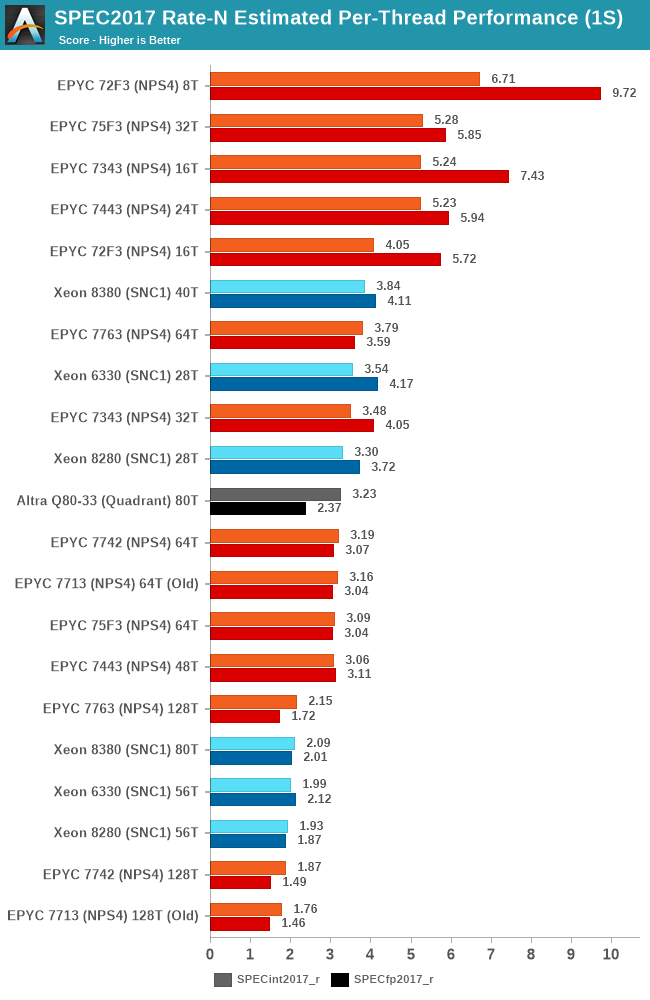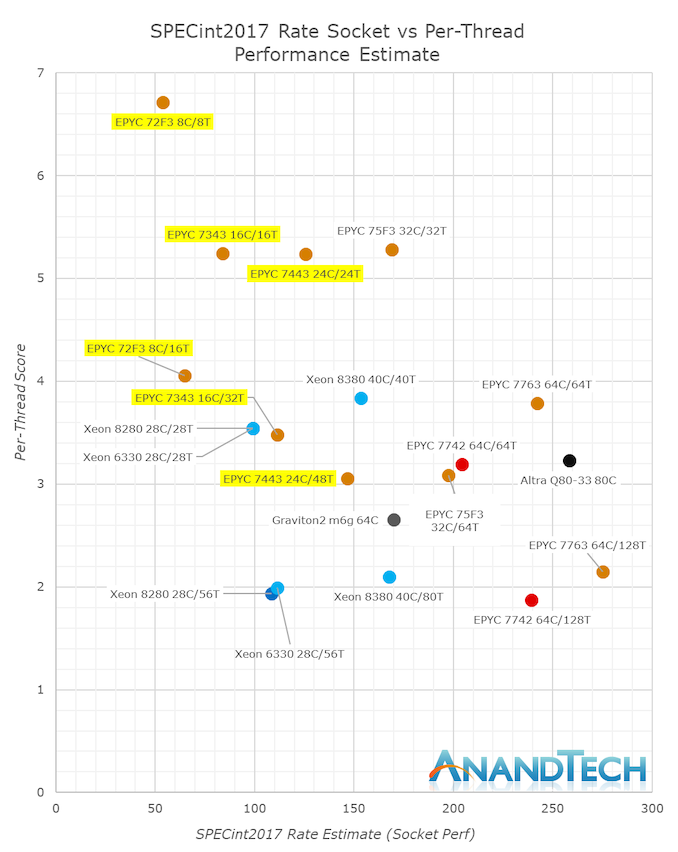AMD EPYC Milan Review Part 2: Testing 8 to 64 Cores in a Production Platform
by Andrei Frumusanu on June 25, 2021 9:30 AM ESTSPEC - Per-Core Performance under Load
A metric that is actually more interesting than isolated single-thread performance, is actually per-thread performance in a fully loaded system. This actually is a measurement and benchmark figure that would greatly interest enterprises and customers which are running software or workloads that are possibly licensed on a per-core basis, or simply workloads that require a certain level of per-thread service level agreement in terms of performance.
It’s also here where AMD’s new low-core count SKUs are extremely interesting, allowing to really distinguish themselves:

Starting off with the EPYC 7343 and the 7443, what’s really interesting to see here is that they’re both well keeping up with the more expensive 75F3 SKU in terms of per-thread performance. The EPYC 7343 actually outperforms the 7443 in the FP test suite because it has 33% less cores to share the L3 cache, and 50% less cores it has to share the DRAM resources against.
The 72F3 here also showcases its extreme positioning in the SKU stack, having the full 32MB L3 dedicated to a single core, and with the full 8-channel DRAM resources shared only amongst 8 cores, it results it outstandingly good per-thread performance. The chip when running 2 threads per core actually still outperforms the per-thread performance of other higher density core count SKUs running only 1 thread per core.
A good visualisation of the socket throughput versus per-thread performance metrics is plotting the various datapoints in a chart on those two axes:
For today’s review, the 7763 and 75F3 move further to the right and higher than they were before, while the new 7443 and 7343 showcase a quite stark competitive situation against Intel’s Xeon 6330.
The Xeon 6330 costs $1894, while the 7443 and 7343 respectively land in at $2010 and $1563. In terms of socket throughput, the Intel chip roughly matches the 16-core AMD counterpart, while the AMD chip is showcasing 48-75% better performance per thread. The 24-core 7443 showcases 26-32% more socket performance while also at the same time having 47-54% better per-thread performance, while only being priced 6% higher. It seems that it’s clear which designs provide the better value.











58 Comments
View All Comments
Andrei Frumusanu - Friday, June 25, 2021 - link
Those results don't contradict anything I'm saying. Given a normalised throughput performance of the socket, for example here where the 16- and 24- core Milan equals or beats the 28-core ICL-SP in many workloads, the Xeon still handily beats those Milan parts in transactional workloads. The 40-core Xeon has 77% of the jbb performance of the 64-core EPYC even though in the int suite it's only at 60%. Those particular STH results work out because the 7543P is $1000 cheaper than the 7543, but for the SKUs we had in today, Intel still is on equal footing in terms of DB performance value.Cllaymenn - Friday, June 25, 2021 - link
Whatever one says about some insignificant single anomaly in some DB test... The fact is that ANY company, from small to large, any corporation needing power, any data centre, hosting, cloud computing, research institutes, universities, will choose EPYC on ZEN3 over even the 8320, because it will allow them to compute faster, make more money per month, and less stress for administrators when there are higher network loads, clouds because AMD will "grind" / process faster the requests/needs of thousands of of thousands of clients simultaneously using servers, because in addition to more compute power has more bandwidth AMD platform especially with 256 threads and 8 channel memory and fast Infinity Fabric and many of the ZEN3 optimizations... and is more flexible (harder to clog or jam Zen2/Zen3 from what I've noticed. ) These processors grind through anything you throw at them without any breathlessness.schujj07 - Friday, June 25, 2021 - link
While Spec is an "industry standard" benchmark, vendors spend hours optimizing for their servers to look better. Therefore as an administrator and designer of a high performance data-center I personally look at Spec results with a grain of salt. For example, Super Micro submitted data for 2 of their A+ AS-1124US-TNRP with dual 75F3 on April 26, 2021. One system has max-jOPS of 276,317 and critial-jOPS of 116,628. The other has a score of 211,179 max-jOPS & 191,813 critical-jOPS. They also have 2 X12DPG-QT6 with dual 8380's and one has scores of 272,500 for max-jOPS & 147,409 for critical-jOPS. The other has scores of 258,368 for max-jOPS & 201,334 for critical-jOPS. In these cases the 75F3 with few cores and threads ends up in a virtual tie with the 8380 in the transactional workload for one of the results, but the second result in the database is a 22-30% lower based on comparison systems. https://www.spec.org/jbb2015/results/res2021q2/Depending on the results you want, the 75F3 is a much better value or of equal value to the 8380. I think now you can see why I take Spec with a grain of salt on their results. Globally saying that Milan has issues in transactional DBs based solely on Spec results isn't a good idea. While I know it is the benchmarks that you choose as they are "industry standard," I think it would be worth while to invest in creating an actual real world scenario DB benchmark that doesn't use Spec.
Andrei Frumusanu - Friday, June 25, 2021 - link
> One system has max-jOPS of 276,317 and critial-jOPS of 116,628. The other has a score of 211,179 max-jOPS & 191,813 critical-jOPS.Which generally makes submitted scores not very useful, we're using apples-to-apples runs here, and while you can argue they're not as optimised, they're comparable to each other.
And I also never said that Milan has *issues*, I'm simply saying that compared to other workloads where there's a massive performance lead for AMD, Intel is still competitive, a view that falls in line with many industry customers.
Cllaymenn - Friday, June 25, 2021 - link
We know that Intel watches the Anandtech website, and that you are aware of this, they also send you expensive hardware for testing, and hope that the results will be more favourable to their new development (e.g. 8320) which they have been working on for a long time. I think it would be unpleasant and uncomfortable to criticise their new products harshly if I were writing a review, but I would rather gently point out which is good at what, which is leading and which still needs to catch up. Because of the awareness of the efforts of hundreds or even thousands of Intel engineers I would not have the heart to criticize their new product, or sharply, clearly say who wins everything and the rest can hide. I know that even the engineers, designers and CPU architects like to read about their new baby after work, and they go to sites like Anandtech with enthusiasm and quiet hope that they have made a better impression on the reviewer and readers, than their previous older products, that we have noticed a significant difference, jump in performance and that it has been appreciated and maybe there will be some nice, positive comments, feedback. It probably gives them a lot of happiness to see people out there enjoying the results of their hard work and another success for the company. Because the 8320 was a huge challenge for these people, it's a brand new fresh 10nm SuperFin technology and a mega monolithic 40 core big piece of silicon. And it works! It may not catch up with the 64 core competition but it's still a huge step forward for them, reaching a significant milestone. Once they mastered this SuperFin 10nm technology to create monolithic 40 core chips they now have a lot of experience and know how to do it even better, especially in a modular architecture where the silicon pieces will be smaller. Many of the threads stem from the creation of the Xeon 8320, so I understand the reviewer's attitude of appreciating the level of technology, sophistication, and performance of their new design. (sorry for some grammatical errors, I'm still improving)bwhitty - Friday, June 25, 2021 - link
Can't tell if you're very subtly implying Andrei is coloring the results in favor of Intel? Perhaps you're not, but anyways it doesn't seem he is. Other than that, I agree thatSmall correction: Ice Lake is on 10nm+, not Super Fin. Tiger Lake is 10SF (10++), and Sapphire Rapids will be on 10 Enhance Super Fin, so 10nm+++.
Tangent: I think that Ice Lake being on the non-SF process actually bodes extremely well for Sapphire Rapids because Ice Lake even in laptops is just not that good from a mfg perspective. It's basically Intel 10nm's first shippable and salvaged process. Super Fin appears far, far better in Tiger Lake versus Ice Lake, and so an improvement on top of that thusly should perhaps finally bring Intel's mfg in line with TSMC 7nm. That gives Sapphire Rapids a good place to be in the first half of 2022 until Genoa rolls out on TSMC 5nm is late 2022 / early 2023.
Cllaymenn - Friday, June 25, 2021 - link
bwhitty. I did not mean favoring Intel products, but a more subdued way of speaking about their performance in relation to ZEN3, a way other than the popular Linus on YT, which is sharply pressing Intel with each premiere of new AMD products.As for Super Fin, I read about it recently in one of the popular IT websites. I typed in google and found a quote
"Intel Xeon Scalable Ice Lake-SP processors were announced some time ago, but we had to wait a while for their premiere. We finally got it - we got to know the technical details of the units, as well as their performance results. Intel Xeon Scalable units (Ice Lake-SP) use the new Sunny Cove microarchitecture, which is expected to translate into up to a 20% increase in IPC over the previous generation Skylake. The chipsets are manufactured using a new 10nm SuperFin process.
As I checked with a few other sources, I now know that this site was wrong about the 83xx series.
Ian Cutress - Friday, June 25, 2021 - link
On 10nm naming, Intel has changed it twice. There are no + or ++ any more.https://www.anandtech.com/show/16107/what-products...
bwhitty - Monday, June 28, 2021 - link
Oh yes, Dr Cutress, I know all these Intel mfg node specifics purely from Anandtech’s breakdownsoutsideloop - Friday, June 25, 2021 - link
Far, far better? Tiger Lake H still sucks power like an anebriated Cleopatra.